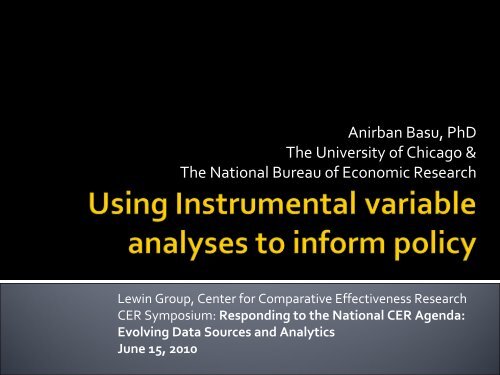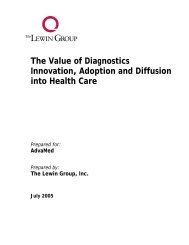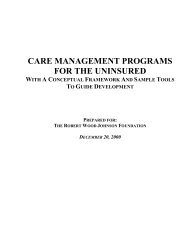Using Instrumental Variable Analyses to Inform ... - The Lewin Group
Using Instrumental Variable Analyses to Inform ... - The Lewin Group
Using Instrumental Variable Analyses to Inform ... - The Lewin Group
Create successful ePaper yourself
Turn your PDF publications into a flip-book with our unique Google optimized e-Paper software.
Anirban Basu, PhD<br />
<strong>The</strong> University of Chicago &<br />
<strong>The</strong> National Bureau of Economic Research<br />
<strong>Lewin</strong> <strong>Group</strong>, Center for Comparative Effectiveness Research<br />
CER Symposium: Responding <strong>to</strong> the National CER Agenda:<br />
Evolving Data Sources and Analytics<br />
June 15, 2010
• Review basic principles of IV analysis<br />
• Present a graphical representation of counterfactual<br />
outcomes and treatment effects<br />
• Study how IV identifies casual treatment effects –<br />
conceptual discussions rather than statistics<br />
• Complications in the presence of heterogeneity of<br />
treatment effects<br />
• Local <strong>Instrumental</strong> <strong>Variable</strong>s (LIV) approach<br />
• An empirical example on evaluating breast cancer<br />
treatments
• Identify instrumental variables that:<br />
• Are correlated with treatment receipt but are uncorrelated<br />
with outcomes.<br />
• Can effectively randomize subjects across treatment arms<br />
achieve equal distribution of both observed and<br />
unobserved confounders across treatment groups.<br />
• Address both overt and hidden biases in estimating the<br />
average treatment effect.<br />
• Split the variation in treatment variable in<strong>to</strong> an exogenous<br />
part and an endogenous part ‐ only the exogenous part is<br />
used <strong>to</strong> estimate treatment effect
Outcome<br />
0 1 2 3 4<br />
Potential Outcomes<br />
With Control Treatment<br />
Levels of Unobserved confounder
Outcome<br />
0 1 2 3 4<br />
Potential Outcomes<br />
With New Treatment<br />
Potential Outcomes<br />
With Control Treatment<br />
Levels of Unobserved confounder
Outcome<br />
0 1 2 3 4<br />
AVERAGE TREATMENT<br />
EFFECT<br />
Potential Outcomes<br />
With New Treatment<br />
Potential Outcomes<br />
With Control Treatment<br />
Levels of Unobserved confounder
Outcome<br />
0 1 2 3 4<br />
Levels of Unobserved confounder
Outcome<br />
0 1 2 3 4<br />
Patients Select <strong>to</strong> Receive<br />
New Treatment<br />
Levels of Unobserved confounder<br />
Patients Select <strong>to</strong> Receive<br />
Control Treatment
Outcome<br />
0 1 2 3 4<br />
Levels of Unobserved confounder<br />
An IV effect<br />
= ATE
Outcome<br />
0 1 2 3 4<br />
Another IV effect<br />
= ATE<br />
Levels of Unobserved confounder
Outcome<br />
0 1 2 3 4<br />
Levels of Unobserved confounder
Outcome<br />
0 1 2 3 4<br />
Levels of Unobserved confounder
Outcome<br />
0 1 2 3 4<br />
Effect of IV2<br />
Effect of IV3<br />
Effect of IV1<br />
Levels of Unobserved confounder<br />
Angrist, Imbens, Rubin, 1996; Brooks, Chrischilles, Scott, Chen‐Hardee, 2003
• LATE ‐ the average treatment effect for<br />
individuals who would change their treatment<br />
choice when instrument level moves<br />
• But who are these “marginal” patients?<br />
• At what margins will my policy induce changes in<br />
treatment choices?<br />
• IV effects (combinations of LATEs) are<br />
misleading as they can be arbitrarily weighted.<br />
Heckman, 1997; McClellan, Newhouse, 1998; Harris, Remler, 1998; Heckman, Vytlacil, 1999
• Mirrors control function and selection models in<br />
economics<br />
• Requires an explicit choice model<br />
• LIV is a method <strong>to</strong> estimate the Marginal Treatment<br />
Effects:<br />
• treatment effect among patients who are at the margin of<br />
choice – the combination of IVs & observed confounders<br />
balances the effects of unobserved confounders on choice<br />
• a small perturbation in IV will change the treatment choice<br />
for these patients<br />
Heckman and Vytlacil, 1999, 2000, 2001; Heckman, Urzua, Vytlacil, 2006
Outcome<br />
0 1 2 3 4<br />
TE for combination<br />
of margins<br />
TE for a margin<br />
Levels of Unobserved confounder<br />
TE for a margin<br />
Heckman and Vytlacil, 1999, 2000, 2001
Outcome<br />
0 1 2 3 4<br />
Levels of Unobserved confounder
• Identify the profile of MTE over the entire support of<br />
the [1‐Pr(Trt Choice)] ~ scaled version of<br />
unobserved confounders at the margins<br />
• Compute ATE, TT, TUT and other policy effects by<br />
simple weighting of the MTEs.<br />
• Can identify situations where current data wont<br />
allow <strong>to</strong> estimate an ATE.<br />
• Can identify situations where complications due <strong>to</strong><br />
heterogeneity can be ignored.<br />
Heckman and Vytlacil, 1999, 2000, 2001
MTE(UD) ( in $)<br />
-100000 0 100000 200000 300000<br />
MTE(UD) Profile and 95% CI with IV = NORTH, FEEDIF<br />
0 .2 .4 .6 .8 1<br />
UD<br />
Propensity <strong>to</strong> choose BCSRT due <strong>to</strong> unobserved confounders <br />
Linear IV approach:<br />
IV(North): $45K<br />
IV(Feedif): $13K<br />
Local IV approach:<br />
ATE(emp): $41K<br />
ATE(extrp): $88K<br />
TT: $52K<br />
Basu, Heckman, Navarro, Urzua, 2007
• In IV analyses, the focus has been more on trying <strong>to</strong><br />
find good instrument and less on interpretation of<br />
results.<br />
• In health, unique opportunity <strong>to</strong> exploit providerlevel<br />
and system level variations that are not linked<br />
<strong>to</strong> outcomes.<br />
• Careful attention is necessary <strong>to</strong> interpret IV results<br />
in the face heterogeneity of treatment effects<br />
• Local instrumental variable approaches can help in<br />
identifying the proper treatment effects relevant for<br />
policy making.
V <br />
( Z , X ) U E ( U )=0<br />
D 1( V<br />
<br />
0),<br />
V V V<br />
V ( Z, X) U E( U D 1( V 0),<br />
V V V )=0<br />
Population level:<br />
P( z) Pr( D 1| Z z )<br />
Pr( U ( z ))<br />
V<br />
V<br />
1 F ( ( z ))<br />
<br />
U<br />
V<br />
F ( ( z )) = 1 - P( z )<br />
U<br />
V<br />
V<br />
V<br />
Individual level:<br />
D 1( V 0)<br />
1( U ( z ))<br />
V<br />
V<br />
1( F ( U ) F ( ( z )))<br />
U V U V<br />
V<br />
1( F ( U ) 1 P( z ))<br />
U<br />
V<br />
V<br />
<br />
1( U 1 P( z))<br />
D<br />
V<br />
where F ( U ) U ~ Uniform[0,1]<br />
U V D<br />
V
D 1( V 0)<br />
=<br />
=<br />
Let<br />
D 1( V 0) 1( U 1 P( z))<br />
D<br />
S( z) 1 P( z)<br />
UD < S(z)<br />
=> D=0<br />
UD > S(z)<br />
=> D=1<br />
Treatment Effects<br />
S(z)<br />
0 1<br />
UD
D 1( V 0)<br />
=<br />
=<br />
Let<br />
D 1( V 0) 1( U 1 P( z))<br />
D<br />
S( z) 1 P( z)<br />
UD < S(z)<br />
=> D=0<br />
UD > S(z)<br />
=> D=1<br />
UD S(z’)<br />
Treatment Effects<br />
=> D=0 => D=1<br />
S(z’)<br />
S(z)<br />
0 1<br />
UD
D 1( V 0)<br />
=<br />
=<br />
Let<br />
D 1( V 0) 1( U 1 P( z))<br />
D<br />
S( z) 1 P( z)<br />
--> S(z')





